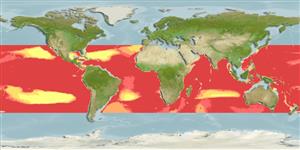Environment: milieu / climate zone / depth range / distribution range
Ekologi
laut batipelagis; kisaran kedalaman 900 - 3500 m (Ref. 58302), usually 2000 - 2600 m (Ref. 58302). Deep-water; 36°N - 45°S, 180°W - 180°E
Atlantic, Indian and Pacific: circumtropical. South China Sea (Ref.74511).
Size / Weight / umur
Maturity: Lm ? range ? - ? cm
Max length : 6.6 cm SL jantan/; (Ref. 4463)
Bathy- to abyssopelagic (Ref. 58302). No apparent vertical migration has been observed (Ref. 4463).
Life cycle and mating behavior
Kematangan | Reproduksi, perkembang biakan | Pemijahan | telur-telur | Fecundity | Larva
Probably dioecious (Ref. 4769).
Badcock, J., 1984. Gonostomatidae. p. 284-301. In P.J.P. Whitehead, M.-L. Bauchot, J.-C. Hureau, J. Nielsen and E. Tortonese (eds.) Fishes of the north-eastern Atlantic and the Mediterranean. volume 1. UNESCO, Paris. (Ref. 4769)
Status IUCN Red List (Ref. 130435)
ancaman kepada manusia
Harmless
penggunaan manusia
Perikanan: tidak ada kepentingan
informasi lanjut
AcuanBudidaya airprofil budidaya airStrainGenetikaElectrophoresesDiturunkanPenyakit-penyakitPengolahanNutrientsMass conversion
mitraGambarStamps, Coins Misc.Suara-suaraCiguateraKecepatanTipe renangArea insangOtolithsOtakPenglihatan / visi
Alat, peralatan
laporan khas
muat turun XML
Sumber internet
Estimates based on models
Preferred temperature (Ref.
123201): 1.8 - 4.1, mean 2.3 °C (based on 2932 cells).
Phylogenetic diversity index (Ref.
82804): PD
50 = 0.5001 [Uniqueness, from 0.5 = low to 2.0 = high].
Bayesian length-weight: a=0.00389 (0.00171 - 0.00885), b=2.99 (2.79 - 3.19), in cm total length, based on LWR estimates for this (Sub)family-body shape (Ref.
93245).
Trophic level (Ref.
69278): 3.1 ±0.3 se; based on size and trophs of closest relatives
Daya lenting (Ref.
120179): sedang, Waktu penggandaan populasi minimum 1.4 - 4.4 tahun (Fec presumed to be <10,000).
Fishing Vulnerability (Ref.
59153): Low vulnerability (10 of 100).
